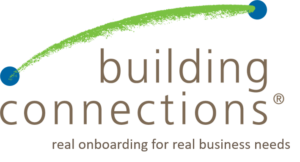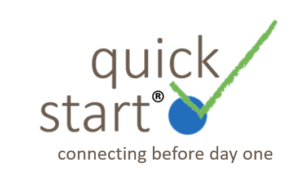Real Leadership in Under a Minute
View our real leadership in under a minute video about the New Hire Experience.
The fact is, you only get one chance to successfully onboard a new hire. Here’s how to get it right.

Our technology solution, building connections®, provides an engaging, automated, learning experience that’s branded for your company.
It addresses the two most critical, real-life areas new hires face: how to integrate rapidly into the organization, and then how to build the productive, positive relationships that lead to success.
We are firm believers that no new hire should be expected to navigate the onboarding process alone, as no form, manual, or even an attractive dashboard can ever fully replace the vital roles that the organization’s hiring manager, HR Partner and other stakeholders play. That’s precisely why all components of building connections® incorporate key players into the Onboarding Program.
Every email notification, every survey to track progress, every element that helps to guide the new hire, hiring manager and key stakeholders all combine to create a total, consistent, engaging, and successful onboarding experience.
building connections® is flexible, so it can address all your new hire needs, whether it’s to cover the period from Offer Acceptance to Day 1, Day 1 through the First 90 days, or both.

The most effective solution is a well-crafted new hire experience supported by a blended approach using both modules of building connections®: quickstart® and the first 90®.

For the client who wants to focus on jump-starting the experience prior to Day 1 by delivering knowledge and tools to the new hire, we offer our proprietary, dynamic web-based solution, quickstart®
quickstart® is designed to lower the new hires’ apprehension while increasing their engagement by providing knowledge about the organization, the experiences they can expect as employees, and information about Day One….ahead of Day One.
This is doubly important when your new hire is a Millennial, as a full one-third of Millennials start seeking a new job a mere six months after joining an organization. The good news is that quickstart® can effectively counter this by incorporating the kind of technology and interactive features that engage them, and make them feel more positive about your culture.
The point is, when a new hire starts off on the right foot, the path to success is far more likely.


The first ninety days are critical for success as the new hire’s goal is to transition from learning to doing — the faster the better.
And the fastest way to do that is to provide them with the right knowledge, and the right connections to the right people that provide the best channel for 2-way feedback.
the first 90® days solution accomplishes all this by delivering a combination of personal, high- touch support options, delivered using advanced technology, through each stage in the process. The online experience doesn’t have to end on day one. Once the new hire starts, building connections®, the first 90® days, gives them access to an interactive dashboard where they can see their progress and view action items and resources that will support them through the first 90 days.
The new hire’s support network (i.e., hiring manager, mentor and/or HR partner) will have access to plug ‘n play roadmaps and dashboards with key milestones and surveys that give insight about what the new hire needs and what needs to be done.

View our new hire experience videos
Real Leadership in Under a Minute – the new hire experience
Our Onboarding Re-Imagined video shows how the new hire experience fits into the total onboarding experience
Our New Leader Transition solution for onboarding is designed to enable the leader to maximize their impact quickly
View our real leadership in under a minute video about the New Hire Experience.
Here are the remaining two of the six strategies borrowed from executive onboarding that you can implement immediately to quickly build organizational knowledge and key relationships and deliver timely feedback to adjust and avoid negative turnover.
As a quick review, part 1 in this 3-part series focused on two onboarding strategies for new hires: 1) making a personal connection by helping them feel like the organization is expecting them, and 2) regulating the amount of information they get. In part 2 we explored two more strategies: 1) focus on building relationships, and 2) create early wins.
Strategy #5: Deliver Early Feedback
Feedback is typically the missing ingredient in an impactful onboarding experience. All new hires need to understand how they are doing and unfortunately, many don’t get the timely feedback they need and deserve.
Integrate these formal feedback components into your current onboarding experience for all new hires. This builds trust and transparency as well as skills for managers and HR partners to have these critical conversations that could literally “save” someone.
The current workforce is now the one with the most diverse demographics in history. Organizations can use this “cheat sheet” to
The current workforce is now the one with the most diverse demographics in history. Organizations can use this “cheat sheet” to remember how each generation prefers to be given feedback:
Boomers generally view feedback to ensure growth and development. They value clear, direct feedback and tend to take criticism very seriously. Baby Boomers also appreciate feedback that is well-researched and backed up by evidence.
Gen Xers see feedback as an opportunity to improve and develop professionally. They prefer feedback that is goal-oriented and results-driven. Gen Xers also value feedback that is honest and open, and they prefer to receive it in a private setting.
Millennials view feedback as a way to build trust and understanding. They tend to be open to constructive criticism, and they appreciate feedback that is solution-oriented. Millennials also value feedback that is timely and consistent.
Gen Z views feedback as a form of collaboration with their colleagues and supervisors. They prefer feedback that is direct and actionable. Gen Zers also appreciate feedback that is tailored to their individual needs and goals.
Source: Hello Leaders Feb 2023
Lastly, an organization’s culture can literally make or break a new hire’s success. If they are not open to feedback and don’t agree or align with the values and behaviors, onboarding, and integration are at risk. One of the many benefits of a formal, structured onboarding experience is that both the new hire and the organization will have early indicators during onboarding that can be reinforced (keep doing that, it’s great!) or curtailed (stop doing that, it’s not good!).
Strategy #6: Don’t Underestimate Culture.
Here are a few things to remember and talk with your new hires about to make sure they are “getting” your culture:
ccccc
Impact on the Organization
In a nutshell, the impact on your organization is significant if your new hires feel as important and as valued as the CEO.
Here are the ways that the new hires benefit:
• Connectedness to the purpose/mission of the org
• Clear sight to contributions to that mission
• Feeling of being valued
• Ownership
• Increased discretionary effort
• Increased engagement
• Pride in work/workplace
• Higher productivity
• Increased creativity/innovation
As you can see, the business Case for Effective Onboarding is clear, and the secrets for success can be found inside the senior leadership onboarding best practices.
Drop us a note to share your success stories or challenges of your new hire experience. We would appreciate the opportunity to share our methods and help you supercharge your onboarding experience!
If you missed part 1 of this 3 part series, click here.
If you missed part 2 of this 3 part series, click here.
Part 1 in this 3-part series focused on two onboarding strategies for new hires: 1) making a personal connection by helping them feel like the organization is expecting them, and 2) regulating the amount of information they get. In part 2 we focus on two more of the six strategies borrowed from executive onboarding that your new hires will immediately benefit from.
Strategy #3: Focus on building relationships
No person is completely independent or “on an island” if they are working for any organization these days. Strong relationships are the key to a successful onboarding experience and sustained work performance, as every engagement survey report will show. Start with your new hires as if they were as important to your success as the CEO would be. Think practically and strategically when selecting the people with whom they should meet and when. We typically focus on this area for new senior leaders, but too often, we slip into all tactical activities for other employees.
Try these strategies to boost your relationship-building for new hires:
All these strategies are “free” and only require a little bit of planning and collaboration with other functions to ensure that your new hires meet and connect with their key partners and internal customers.
Strategy #4: Create Early Wins
Early Wins are one of the best-kept secrets in a robust onboarding experience–maybe because it seems obvious, or maybe because we think of them as “job duties” and haven’t framed them as anything else. Senior leaders understand the power and impact of making some key contributions early to gain confidence, trust, and momentum within the organization.
Use these strategies to begin creating Early Wins during the onboarding process:
This “trick” can also be leveraged for every one of your new hires with a simple conversation and a worksheet. When we used this strategy with a client, the new hire gained better clarity about what the organization needed from her and was able to execute a few of those things in the first ninety days or so. As a result, the new hire felt increasingly more confident about her decision to join the company. Win, win, win!
Stats show that new hires are deciding as to whether they will stay or leave a new role during the first six months, so using Early Wins can help cement both the new hire’s decision to stay and give the organization indicators as to how they are doing against a formal plan.
Read about the next two strategies in part 3 of this series. If you missed part 1 of this 3 part series, click here.
Onboard new hires like a CEO? What would an “executive onboarding experience” look like and how could it impact your new hires’ engagement levels? Per Gallup, 88% of employees don’t think their current organization is good at onboarding and 76% of HR professionals don’t think they are doing a good job at onboarding employees. Robust onboarding addresses organizational challenges–attracting top talent, increasing engagement, boosting productivity, and reducing high turnover.
Here are six strategies borrowed from executive onboarding that you can implement immediately to quickly build organizational knowledge and key relationships and deliver timely feedback to adjust and avoid negative turnover.
Employees at all levels are dissatisfied with their onboarding experiences, and the cost of replacing them has never been higher; however, there are some “bright spots” of best practices that tend to show up for the highest-level leaders, like CEOs.
Audrey Jarre, Head of Learning at 306Learning, put it plainly:
“A mere 12% of employees agree their organization does a good job of onboarding new employees. What’s more, if your organization isn’t among the ones that get onboarding right, it’s likely your new hires will be hunting for new jobs before you can say pro-ba-tion.”
We are not suggesting that all components of senior leader onboarding translate to the rest of the population, but here are some scalable strategies.
Strategy #1: Make it personal.
No CEO or senior leader would appreciate a generic onboarding experience, so why put your new hires through one? Try one or all of the following to make your new hires feel welcomed and expected:
We worked with a client to create a virtual tour of their offices narrated by the CEO so that the new hires would have some familiarity with the environment before Day One. The video was on the new hire onboarding portal that we helped them create. The “tour” was a fun, unexpected extra feature added to what the new hires need to know in the pre-start phase of onboarding; and some new hires watched it several times, even sharing it with friends and family members. The portal also allowed the manager to add a personal welcome message which she simply recorded from her phone and uploaded to the site. These personal touches helped the organization’s employment brand stand out and kept new hires engaged and excited before they ever walked into the building.
Strategy #2: Don’t use a firehose approach.
Too often, new hires are inundated with tasks, training, and meetings in the first weeks which makes it difficult for them to really absorb the knowledge they need. They forget who they met with during the first week and can miss key onboarding information if it is not clear how it is attached to their roles.
Use these tips to combat the “firehose” approach:
Our client, Mark, benefitted from this approach when we helped his manager and HR partner build a realistic onboarding plan with “meet-and-greet” meetings that supported his plan’s objectives and timing.
An example was that he met 1:1 with other functional heads who helped him understand how the company measures success, how they make decisions, and how long he was “allowed to be new” in this organization.
Cultural learning during the first weeks on the job is priceless and this approach avoids early burn-out and costly missteps. If new hires are bombarded early with meetings, presentations, and deliverables, they can often miss the most important onboarding lessons.
This is Part 1 of 3 installments of our series, “Onboard Like a CEO: 6 Strategies from the Corner Office that Will Engage and Develop Your New Hires. Read about the next two strategies in an upcoming issue.
We start with thoughtfully diagnosing the team’s current culture by using available data, assessments and interviews.
This provides the team leader with a clear view of what is getting in the way of the team’s success.
We design a series of structured team sessions that:
Measure progress by leveraging CTD’s team-connect Survey to: